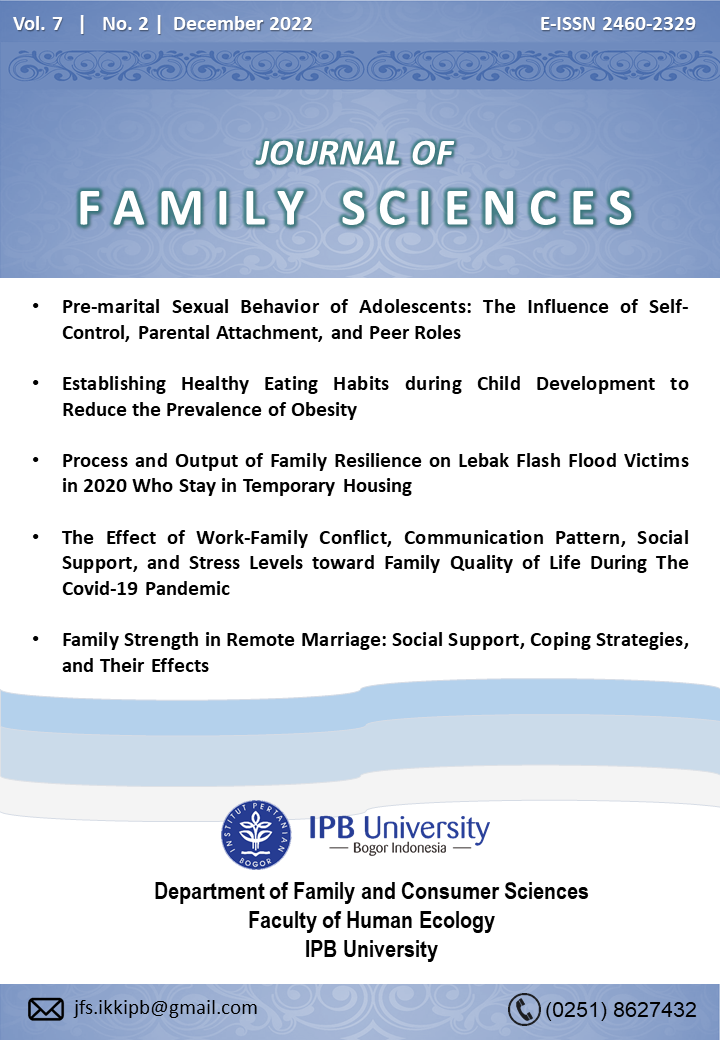Establishing Healthy Eating Habits during Child Development to Reduce the Prevalence of Obesity
Establishing Healthy Eating Habits during Child Development to Reduce the Prevalence of Obesity
Abstract
Obesity is becoming a major public health problem in the general population lately, affecting children and adults. The numbers of obesity could be diminished by performing healthy eating habits and lifestyles at a child's developmental age as they share the same risk factors and are intimately related. This paper is a literature review using various references from relevant journals to examine problems and find answers to existing problems. References were obtained through search engines, then selected based on their closeness to the topic raised in this study. Environments that have low access to healthy foods such as fresh fruit and vegetables are generally found in areas that have socioeconomic problems or in minority groups; on the contrary, areas or groups that have good access to fast food vendors are usually offering foods that contain high sugar and fat. Healthy eating habits can be formed by providing examples of healthy habits in children and increasing parents' attention to their eating patterns.
Downloads
References
Ambrosini, G.L. (2013). Childhood dietary patterns and later obesity: a review of the evidence. Proceedings of the Nutrition Society, 73(1), 1-10. doi: 10.1017/S0029665113003765
Bekhwani, A.R., & Khan, M. (2022). Various risk factors of overweight and obesity among children aged 5-16 Years. Journal of the College of Physicians and Surgeons--Pakistan: JCPSP, 32(6), 763-767. doi: 10.29271/jcpsp.2022.06.763
Birch, L.L. (1980). Effects of peer models' food choices and eating behaviors on preschoolers' food preferences. Child development, 489-496. doi: https://doi.org/10.2307/1129283
Brown, R., & Ogden, J. (2004). Children’s eating attitudes and behaviour: a study of the modelling and control theories of parental influence. Health education research, 19(3), 261-271. doi: https://doi.org/10.1093/her/cyg040
Brownson, R.C., Boehmer, T.K., & Luke, D.A. (2005). Declining rates of physical activity in the United States: what are the contributors. Annual review of public health, 26, 421-443. doi: 10.1146/annurev.publhealth.26.021304.144437
Candra, A., Wahyuni, T.D., & Sutriningsih, A. (2016). Hubungan antara aktivitas fisik dan pola makan dengan kejadian obesitas pada remaja di SMA Laboratorium Malang. Nursing News, 1(1), 1-6.
Christine H., Aaltje E.M., & Fona B. (2016). Faktor-Faktor Risiko terhadap Obesitas pada Remaka di Kota Bitung. Journal e-Biomedik (eBm), 4(1). doi: https://doi.org/10.35790/ebm.v4i1.11040
Creatore, M.I., Glazier, R.H., Moineddin, R., Fazli, G.S., Johns, A., Gozdyra, P., Matheson, F.I., Kaufman-Shriqui, V., Rosella, L.C., Manuel, D.G., & Booth, G.L. (2016). Association of neighborhood walkability with change in overweight, obesity, and diabetes. JAMA, 315, 2211-2222. doi: 10.1001/jama.2016.5898
Cuellar, J., Jones, D.J., & Sterrett, E. (2015). Examining parenting in the neighborhood context: A review. Journal of Child and Family Studies, 24(1), 195-219. doi: 10.1007/s10826-013-9826-y
de Mello, D.F., Henrique, N.C.P., Pancieri, L., Veríssimo, M.D.L.Ó.R., Tonete, V.L.P., & Malone, M. (2014). Child safety from the perspective of essential needs. Rev. Latino-Am. Enfermagem, 22(4), 604-10. doi: 10.1590/0104-1169.3651.2458
Dube, S.R., Miller, J.W., Brown, D.W., Giles, W.H., Felitti, V.J., Dong, M., & Anda, R.F. (2006). Adverse childhood experiences and the association with ever using alcohol and initiating alcohol use during adolescence. Journal of Adolescent Health, 38(4), 444-e1. doi: 10.1016/j.jadohealth.2005.06.006
Dunton, G.F., Kaplan, J., Wolch, J., Jerrett, M., & Reynolds, K.D. (2009). Physical environmental correlates of childhood obesity: a systematic review. Obesity reviews, 10(4), 393-402. doi: 10.1111/j.1467-789X.2009.00572.x
Evan, Wiyono., & Candrawati, E. (2017). Hubungan antara pola makan dengan kejadian obesitas pada mahasiswa di Universitas Tribhuwana Tunggadewi Malang. Nursing News, 2(3).
Finnane, J.M., Jansen, E., Mallan, K.M., & Daniels, L.A. (2017). Mealtime structure and responsive feeding practices are associated with less food fussiness and more food enjoyment in children. Journal of nutrition education and behavior, 49(1), 11-18. doi: 10.1016/j.jneb.2016.08.007. doi: 10.1016/j.jneb.2016.08.007
Fisher, J.O., & Birch, L.L. (1999). Restricting access to palatable foods affects children's behavioral response, food selection, and intake. The American Journal of Clinical Nutrition, 69(6), 1264-1272. doi: 10.1093/ajcn/69.6.1264
Gatherer, A., Parfit, J., Porter, E., & Vessey, M. (1979). Is health education effective? an overview of evaluated studies. Health Education Council, London, 22(3), 364-389. doi: 10.1177/109019819402200308
Hanan, R., Badrah, S, & Noviasty, R. (2021). Pola makan, aktivitas fisik dan genetik mempengaruhi kejadian obesitas pada remaja. Jurnal Kesehatan Metro Sai Wawai, 14(2), 120 - 129. Available from: Journal homepage https://ejurnal.poltekkes-tjk.ac.id/index.php/JKM.doi: http://dx.doi.org/10.26630/jkm.v14i2.2665
Hanson, J.L., Hair, N., Shen, D.G., Shi, F., Gilmore, J.H., Wolfe, B.L., & Pollak, S.D. (2013). Family poverty affects the rate of human infant brain growth. PloS one, 8(12), p.e80954. doi: https://doi.org/10.1371/journal.pone.0080954
Hendrickson, D., Smith, C., & Eikenberry, N. (2006). Fruit and vegetable access in four low-income food deserts communities in Minnesota. Agriculture and Human Values, 23(3), 371-383. doi: 10.1007/s10460-006-9002-8
Hill, J.L., You, W., & Zoellner, J.M. (2014). Disparities in obesity among rural and urban residents in a health disparate region. BMC Public Health, 14(1), 1051. doi: 10.1186/1471-2458-14-1051
Institute for Health Metrics and Evaluation (IHME). (2022). Indonesia. Available online: https://www.healthdata.org/indonesia (accessed on 27 September 2022).
Ishaque, A., Ahmad, F., Zehra, N., & Amin, H. (2012). Frequency of and factors leading to obesity and overweight in school children. J Ayub Med Coll Abbottabad, 24(2), 34-38. doi:
Jiao, J., Moudon, A.V., Ulmer, J., Hurvitz, P.M., & Drewnowski, A. (2012). How to identify food deserts: measuring physical and economic access to supermarkets in King County, Washington. American journal of public health, 102(10), 32-39. doi: 10.2105/AJPH.2012.300675
Kaushal, N., & Rhodes, R.E. (2014). The home physical environment and its relationship with physical activity and sedentary behavior: a systematic review. Preventive medicine, 67, 221-237. doi: 10.1016/j.ypmed.2014.07.026
Kearney, J. (2010). Food consumption trends and drivers. Philosophical transactions of the royal society B: biological sciences, 365(1554), 2793-2807. doi: https://doi.org/10.1098/rstb.2010.0149
[Kemenkes] Kementerian Kesehatan Republik Indonesia. (2018). Riset Kesehatan Dasar (Riskesdas) Badan Penelitian dan Pengembangan Kesehatan Kementerian RI tahun 2018. Jakarta(ID): Indonesia
Khumaidi, M. (1989). Gizi Masyarakat. Bogor(ID): Institut Pertanian Bogor
Knudsen, E.I. (2004). Sensitive periods in the development of the brain and behavior. Journal of cognitive neuroscience, 16(8), 1412-1425. doi: 10.1162/0898929042304796
Lai, E.T., Wickham, S., Law, C., Whitehead, M., Barr, B., & Taylor-Robinson, D. (2019). Poverty dynamics and health in late childhood in the UK: evidence from the Millennium Cohort Study. Archives of Disease in Childhood, 104(11), 1049-1055. doi: 10.1136/archdischild-2018-316702
Lee, S.Y., Ha, S.A., Seo, J.S., Sohn, C.M., Park, H.R., & Kim, K.W. (2014). Eating habits and eating behaviors by family dinner frequency in the lower-grade elementary school students. Nutrition Research and Practice, 8(6), 679-687. doi: 10.4162/nrp.2014.8.6.679
Lepper, M.R., Sagotsky, G., Dafoe, J.L., & Greene, D. (1982). Consequences of Superfluous Social Constraints: Effects on Young Children's Social Inferences and Subsequent Intrinsic Interest. Journal of Personality and Social Psychology, 42(1), 51-65. doi: 10.1037/0022-3514.42.1.51
Lowe, C.E., Dowey, A.J., & Horne, P.J. (1998). Changing what children eat. In The Nation's Diet: The Social Science of Food Choice, ed. A Murcott, 57-80.
Maes, H.H., Neale, M.C., & Eaves, L.J. (1997). Genetic and environmental factors in relative body weight and human adiposity. Behavior genetics, 27(4), 325-351.
Maitland, C., Stratton, G., Foster, S., Braham, R., & Rosenberg, M. (2013). A place for play? The influence of the home physical environment on children's physical activity and sedentary behaviour. The International Journal of Behavioral Nutrition and Physical Activity, 10, 99-99.
Minh, A., Muhajarine, N., Janus, M., Brownell, M., & Guhn, M. (2017). A review of neighborhood effects and early child development: How, where, and for whom, do neighborhoods matter? Health & Place, 46, 155-174.
Montaño, Z., Smith, J.D., Dishion, T.J., Shaw, D.S., & Wilson, M.N. (2015). Longitudinal relations between observed parenting behaviors and dietary quality of meals from ages 2 to 5. Appetite, 87, 324-329.
Mustard, J.F. (2012). Early Human Development–Equity from the Start–Latin America. Rev Latino Am Cienc Soc Niñez, 7(2), 639-680.
Ng, S.W., & Popkin, B.M. (2012). Time use and physical activity: a shift away from movement across the globe. Obesity reviews, 13(8), 659-680. doi: 10.1111/j.1467-789X.2011.00982.x
Popkin, B.M. (2005). Using research on the obesity pandemic as a guide to a unified vision of nutrition. Public Health Nutrition, 8, 724-729. doi: 10.1079/PHN2005776
Rosenheck, R. (2008). Fast food consumption and increased caloric intake: a systematic review of a trajectory towards weight gain and obesity risk. Obesity reviews, 9, 535-547. doi: 10.1111/j.1467-789X.2008.00477.x
Sallis, J.F., Prochaska, J.J., & Taylor, W.C. (2000). A review of correlates of physical activity of children and adolescents. Medicine and science in sports and exercise, 32, 963-975. doi: 10.1097/00005768-200005000-00014
Saraswati, S. K., Rahmaningrum, F. D., Pahsya, M. N. Z., Paramitha, N., Wulansari, A., Ristantya, A. R., Sinabutar, B. M., Pakpahan, V. E., & Nandini, N. (2021). Literature review: factor risiko penyebab obesitas. Media Kesehatan Masyarakat Indonesia, 20(1), 70-74.
Simatupang, M.R. (2008). Pengaruh pola konsumsi, aktivitas fisik dan keturunan terhadap kejadian obesitas pada siswa sekolah dasar swasta di Kecamatan Medan Baru Kota Medan. [Tesis]. Medan: Universitas Sumatera Utara
Shin, S.H., Hong, H.G., & Hazen, A.L. (2010). Childhood sexual abuse and adolescent substance use: A latent class analysis. Drug and alcohol dependence, 109(1-3), 226-235. doi: 10.1016/j.drugalcdep.2010.01.013
Shin, S.H., Miller, D.P., & Teicher, M.H. (2013). Exposure to childhood neglect and physical abuse and developmental trajectories of heavy episodic drinking from early adolescence into young adulthood. Drug and alcohol dependence, 127(1-3), 31-38. doi: 10.1016/j.drugalcdep.2012.06.005
Shonkoff, J.P., Garner, A.S., Siegel, B.S., Dobbins, M.I., Earls, M.F., McGuinn, L., Pascoe, J., & Wood, D.L. (2012). The Lifelong Effects of Early Childhood Adversity and Toxic Stress. Pediatrics, 129(1), e232-e246. doi: 10.1542/peds.2011-2663
Timmermans, J., Dijkstra, C., Kamphuis, C., Huitink, M., Van der Zee, E., & Poelman, M. (2018). ‘Obesogenic’school food environments? An urban case study in the Netherlands. International journal of environmental research and public health, 15(4), 619. doi: 10.3390/ijerph15040619
Walker, R.E., Keane, C.R., & Burke, J.G. (2010). Disparities and access to healthy food in the United States: A review of food deserts literature. Health & place, 16(5), 876-884. doi: 10.1016/j.healthplace.2010.04.013
Widiantini W, & Tafal Z. (2014). Aktivitas fisik, stres, dan obesitas pada Pegawai Negeri Sipil. Jurnal Kesehatan Masyarakat Nasional, 8(7), 330-336.
Yulia, K., Fakhriadi, R., & Yulidasari, F. (2016). Hubungan antara pola makan, asupan energy, aktivitas fisik, dan durasi tidur dengan kejadian obesitas pada polisi. Jurnal Publikasi Kesehatan Masyarakat Indonesia, 3(3), 112-117. http://dx.doi.org/10.20527/jpkmi.v3i3.2759
Authors who publish with this journal agree to the following terms:
- Authors retain copyright and grant the journal right of first publication with the work simultaneously licensed under a Creative Commons Attribution 4.0 International License that allows others to share the work with an acknowledgement of the work's authorship and initial publication in this journal.
- Authors are able to enter into separate, additional contractual arrangements for the non-exclusive distribution of the journal's published version of the work (e.g., post it to an institutional repository or publish it in a book), with an acknowledgement of its initial publication in this journal.
- Authors are permitted and encouraged to post their work online (e.g., in institutional repositories or on their website) prior to and during the submission process, as it can lead to productive exchanges, as well as earlier and greater citation of published work (See The Effect of Open Access).



_001.png)



